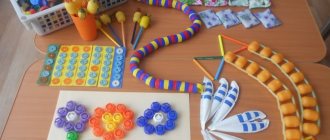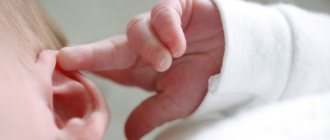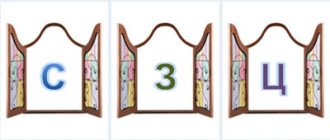Our speech is a stream of sounds that are formed with the participation of the organs of the speech apparatus and breathing. With proper speech breathing, we get correct sound production, correct volume, expressiveness and fluency of speech. Accordingly, harmonious speech is closely related to the development of speech breathing: how we breathe while speaking, with what force we inhale and exhale air, how we distribute exhalation and maintain pauses in conversation. All these skills in children can and should be improved. What games for developing speech breathing can be used for this? When to start?
What is the difference between speech breathing and physiological breathing?
Physiological breathing is involuntary; it serves us to ensure proper gas exchange in the body. Short and uniform inhalations and exhalations are performed through the nose: inhale-exhale-pause.
The main feature of the development of speech breathing in children is the emphasis on exhalation (it should be much longer than inhalation). First, take a short breath, followed by a short pause, then a long exhale, filled with sounds or words.
A person cannot speak while inhaling. That is why the main role in correct speech production is played by the training of speech exhalation. Here it is important to be able not to draw in as much air as possible, but to train the skill of using it rationally for a long, smooth exhalation. Relaxation of the muscles involved in such breathing occurs voluntarily, depending on our desire.
Imperfections in children's speech breathing can manifest themselves in different ways.
- For example, a child suddenly becomes silent while speaking, pauses and inhales to finish a phrase that he may forget while inhaling. To avoid this, the child is forced to finish the phrase, lowering the tone, sometimes switching to a whisper. This indicates that the baby does not know how to take in enough air during inspiration.
- Another example. The baby speaks very quietly, without finishing the thought. His speech is unclear and fast, which interferes with correct intonation and pauses. Here the child's respiratory apparatus is poorly developed. This is often due to the presence of chronic diseases of the ENT organs or a sedentary lifestyle when lung capacity suffers.
Playing football
This is the most common game for breathing exercises, but no less beautiful for that. The process of constructing a gate from improvised means alone is worth it.
And then we roll a small ball out of paper or a napkin and start playing. Only instead of legs we use breathing.
You can play together or with a whole group.
The game not only develops breathing, but also teaches you how to control its strength and direction. And of course, it trains that very long exhalation, which is longer than the inhalation.
Organizing correct exhalation
In order for speech breathing to be correct, it is important to demonstrate to the baby the technique of performing it:
- the inhalation is short but strong, you need to inhale through your nose, and the expansion of the diaphragm will be noticeable;
- exhalation should be smooth, without sudden shocks (lips drawn out into a tube);
- exhalation is carried out through the mouth, otherwise speaking will not be possible;
- you need to exhale “all the way”, after which you take a short pause (about 2 - 3 seconds).
Most kids don't get it right the first time. To help them master breathing while speaking, special training will be needed. But don’t be afraid of this phrase: training consists of playing a variety of fun games with your child, which will bring him a lot of positive emotions, while simultaneously developing the power of exhalation.
To maintain interest in such activities, it is important to organize speech breathing exercises for children correctly:
- They are allotted from 3 minutes at an early age to 6 minutes at an older preschool age.
- Such games are played in a well-ventilated room: there should be enough fresh air during the lesson.
- You need to play with your breathing before eating.
- By the time the exercises begin, the child should be healthy and in a good mood.
- Parents always accompany the games with emotional comments.
Playing with breath
You can start training in speech breathing by the end of the baby’s first year of life. Surely mommy will want to teach him how to blow out the candle on his first anniversary cake.
Place the candle at a short distance from the baby so that the force of his exhalation is enough to extinguish it. Otherwise, he will quickly lose interest in an exercise that does not work out. Be prepared for the fact that your child may not succeed either the first or even the fifth time. Show him an example, you can encourage him with phrases like: “Oh, what a stubborn little candle we have, she won’t give up! But Katyusha is stronger than her, right? Let's try to defeat her one more time!"
To make it more interesting for the baby, you can present this game as a birthday party for some toy (dolls, bears, bunnies): put out a small cake with a candle, “invite” other toys.
This will be the beginning of breathing exercises. You can add another fun activity to blowing out a candle: blowing soap scum off your hands while your baby is taking a bath. After a year, the baby can already try blowing dandelions while walking, blowing a child’s pipe, and showing how a samovar puffs.
For the most part, games for the development of speech breathing are intended for children, starting from early preschool age (3 - 4 years). By the way, many of them are held in kindergartens.
Breathing games
To carry out these games you will need simple equipment: paper devices, whistle toys, balloons.
- Flying butterflies.
It is necessary to cut out several paper butterflies and tie them by a thread to a strong rope at a short distance from each other. Butterflies should be positioned at the level of the child's face. An adult shows him how to blow on butterflies so that they begin to “flutter”, and then asks him to repeat. It is important that the baby stands straight, does not raise his shoulders as he exhales, does not puff out his cheeks, does not suck in air, and pulls his lips forward a little.
- Rainbow bubbles.
The mother shows the child how to blow soap bubbles using a straw, a cocktail tube or a special frame that comes with the bubbles. Then the baby tries to repeat. He may have difficulties, so the task of adults is to support the baby and motivate him.
- Whistles.
You will need wooden, clay or plastic whistle toys. The child is asked to whistle to hear his bird or animal sing. This is a very exciting game for preschool children; they will “whistle” with pleasure.
- Magic breeze.
You need to prepare “trees” - panicles made of colored paper cut into strips and attached to a stick (you can use Christmas tree “rain” instead of paper). An adult shows the child a magic tree and offers to blow on it to hear a light magical breeze.
- Flying ball.
To play, you need an inflated balloon, which is hung at the level of the baby's face. The parent shows the child how to blow on the balloon to make it fly up. The little player must repeat the exercise. A more difficult option is that the ball is not tied, and the child’s task is to lift it up and hold it there, using only the force of exhalation.
Card index of games for the development of speech breathing in preschool children
The source of the formation of speech sounds is an air stream leaving the lungs through the larynx, pharynx, oral cavity or nose to the outside. Correct speech breathing ensures normal sound production, creates conditions for maintaining normal speech volume, strictly observing pauses, maintaining fluency of speech and intonation expressiveness.
Speech breathing disorders can be a consequence of general weakness, adenoid growths, various cardiovascular diseases, etc.
Such imperfections in speech breathing, such as the inability to rationally use exhalation, speech while inhaling, incomplete renewal of air supply, etc., which negatively affect the development of children’s speech, may be due to improper upbringing and insufficient attention of adults to children’s speech. Children who have weakened inhalation and exhalation, as a rule, speak quietly and have difficulty pronouncing long phrases. If air is used irrationally, the fluency of speech is disrupted, since children are forced to take in air in the middle of a sentence. Often such children do not finish the words and often pronounce them in a whisper at the end of the phrase. Sometimes, in order to finish a long phrase, they are forced to speak while inhaling, causing speech to become unclear, convulsive, and choking. A shortened exhalation forces you to speak phrases at an accelerated pace, without observing logical pauses.
When starting to develop speech breathing in a child, it is necessary first of all to form a strong, smooth oral exhalation. At the same time, it is necessary to teach the child to control the exhalation time and use air sparingly. Additionally, the child develops the ability to direct the air stream in the desired direction.
During the games described in the article, constant monitoring of correct breathing is necessary.
Remember the parameters of correct oral exhalation:
- exhalation is preceded by a strong inhalation through the nose - “we take a full chest of air”;
- exhalation occurs smoothly, and not in jerks;
— during exhalation, the lips form a tube; you should not purse your lips or puff out your cheeks;
- during exhalation, the air comes out through the mouth, you should not allow the air to escape through the nose (if the child exhales through the nose, you can pinch his nostrils so that he feels how the air should come out);
- you should exhale until the air runs out;
— while singing or talking, you should not take in air with frequent short breaths.
When playing games aimed at developing a child's breathing, it is necessary to keep in mind that breathing exercises quickly tire the child and can even cause dizziness. Therefore, such games must be limited in time (you can use an hourglass) and be sure to alternate with other exercises.
The games and exercises listed below will help teach your child to smoothly exhale a strong, directed stream of air through his mouth.
Games and exercises for development
smooth oral exhalation
Fly, butterfly!
Target:
development of prolonged continuous oral exhalation; activation of the labial muscles.
Equipment
: 2-3 bright paper butterflies.
Progress of the game:
Before starting the lesson, tie a thread 20-40 cm long to each butterfly, attach the threads to the cord at some distance from each other. Pull the cord so that the butterflies hang at the level of the standing child’s face.
The teacher shows the child butterflies and invites them to play with them.
- Look how beautiful the colorful butterflies are! Let's see if they can fly. The teacher blows on butterflies.
- Look, they're flying! How alive! Now you try to blow. Which butterfly will fly farthest?
The child stands near the butterflies and blows on them. It is necessary to ensure that the child stands straight, does not raise his shoulders when exhaling, blows on one exhalation without taking in air, does not puff out his cheeks, and slightly pushes his lips forward.
You can blow for no more than 10 seconds with pauses to avoid dizziness.
Breeze
Target:
development of strong smooth oral exhalation; activation of the labial muscles.
Equipment:
paper plumes (brooms).
Progress of the game:
Before starting the game, you need to prepare the brooms. To do this, attach strips of colored paper to a wooden stick. You can use thin tissue paper or a “rain” Christmas tree decoration.
The teacher offers to play with a broom. Shows how to blow on paper strips, then offers to blow on the child.
- Imagine that this is a magic tree. The breeze blew and the leaves rustled on the tree! Like this! Now you blow!
The game can be played individually or in a group of children. In the second case, children blow on their brooms at the same time.
Autumn leaves
Target:
teaching smooth free exhalation; activation of the labial muscles.
Equipment:
autumn maple leaves, vase.
Progress of the game:
Before class, collect a bouquet of autumn leaves with your child (preferably maple, since they have long stems) and place them in a vase. Offer to blow on the leaves.
— You and I collected beautiful leaves in the park. Here is a yellow leaf, and here is a red one. Do you remember how the leaves rustled on the branches? Let's blow on the leaves!
An adult, together with a child or a group of children, blows on the leaves in a vase and draws their attention to the rustling sound the leaves make.
Leaf fall
Target:
teaching smooth free exhalation; activation of the labial muscles.
Equipment:
yellow, red, orange leaves cut out of thin double-sided colored paper; bucket.
Progress of the game:
The teacher lays out leaves on the table and reminds the children about autumn.
- Imagine that it is autumn now. Red, yellow, orange leaves fall from the trees. The wind blew and scattered all the leaves on the ground! Let's make a wind - let's blow on the leaves!
The adult and the children blow on the leaves until all the leaves are on the floor. In this case, it is necessary to ensure that oral exhalation is carried out correctly, as well as to ensure that children do not become overtired.
- All the leaves on the ground... Let's collect the leaves in a bucket.
The teacher and children collect leaves. Then the game repeats again.
It is snowing!
Target:
formation of a smooth long exhalation; activation of the labial muscles.
Equipment:
pieces of cotton wool.
Progress of the game:
The teacher lays out pieces of cotton wool on the table and reminds the children about winter.
— Imagine that it is winter now. Snow is falling outside. Let's blow on snowflakes!
An adult shows how to blow on cotton wool, the children repeat. Then everyone raises the cotton wool and the game is repeated again.
Dandelion
Target:
development of smooth, long exhalation through the mouth; activation of the labial muscles.
Progress of the game:
The game is played outdoors - in a clearing where dandelions grow. The adult invites the children to find among the yellow dandelions the ones that have already bloomed and pick them. Then he shows how you can blow on a dandelion to make all the fluff fly off. After this, he invites the children to blow on their dandelions.
- Let's blow on the dandelions! Blow once, but strongly, so that all the fluff flies off. Look, the fluffs are flying like little parachutes.
You can arrange a competition: each child blows on his own dandelion once. The winners are those children who do not have a single fluff left on the head of the flower.
You can also organize the game “Grandfather or Grandmother?”:
- Let's play the game “Grandfather or Grandmother?”! Blow on your dandelions only once. If there are no fluffs left on the flower head, it is a bald head. So it turned out to be a grandfather. If the fluff remains - these are hairs on the head - then it turns out to be a woman. The one who gets the grandfather wins!
Pinwheel
Target:
development of long, smooth exhalation; activation of the labial muscles.
Equipment:
spinning toy.
Progress of the game:
Before starting the game, prepare a spinning toy. You can make it yourself using paper and a wooden stick.
Show your child the fidget spinner. On the street, demonstrate how it begins to spin when the wind blows. Then offer to blow on it yourself:
- Let's make a wind - let's blow on the turntable. That's how it turned out! Blow even harder and the spinner spins faster.
The game can be played individually or in a group of children.
Wind Song
Target:
development of strong smooth exhalation; activation of the labial muscles.
Equipment:
Chinese bell "song of the wind".
Progress of the game:
Hang the bell at a convenient distance for the child (at the level of the face of a standing child) and offer to blow on it. Pay attention to how melodic the sound is. Then suggest blowing harder - the sound has become louder.
The game can be played individually or in a group of children.
Fly, birds
!
Target:
development of long-term directed smooth oral exhalation; activation of the labial muscles.
Equipment:
2-3 colorful birds folded from paper (origami).
Progress of the game:
The child is sitting at the table. One bird is placed on the table opposite the child. The teacher invites the child to blow on the bird so that it flies as far as possible (you can blow once).
- What a beautiful bird you have! Can she fly? Blow so that the bird flies far away! You can blow once. Inhale and get more air. The bird has flown!
During a group game, you can arrange a competition between two or three children: each blows on his own bird. The one whose bird flies farthest wins. The adult makes sure that the children do not puff out their cheeks, blow only once, and do not strain too much.
Roll, pencil!
Target:
development of long, smooth exhalation; activation of the labial muscles.
Equipment:
pencils with a smooth or ribbed surface.
Progress of the game:
The child is sitting at the table. Place a pencil on the table at a distance of 20 cm from the child. First, the adult shows how to blow forcefully on a pencil so that it rolls to the opposite end of the table. Then he invites the child to blow on the pencil. The second participant in the game catches the pencil at the opposite end of the table. You can continue the game by sitting opposite each other and rolling each other's pencil from one end of the table to the other.
When organizing a game in a group, you can arrange a competition: two children sit at a table with pencils in front of them. You can only blow on the pencil once. The one whose pencil rolls farthest wins.
Funny balls
Target:
development of strong smooth directed exhalation; activation of the labial muscles.
Equipment:
lightweight plastic ball.
Progress of the game:
You can play with balls in the same way as with pencils (see previous game). You can make the game more difficult. Draw a line on the table. Then take the ball and place it in the middle of the table (on the line). Two children sit at a table opposite each other, on opposite sides of a ball on a line.
- You need to blow on the ball so that it rolls to the opposite side of the table. And you need to try so that the ball does not fall on your part of the table. You need to blow harder. Let's start!
The winner is the one who managed to blow the ball over the line to the opposite side of the table.
Balloon
Target:
development of strong smooth oral exhalation; activation of the labial muscles.
Equipment:
an ordinary balloon on a string; gas balloon.
Progress of the game:
Hang the balloon at the level of your child's face. Blow on the balloon so that it flies high, then offer to blow on the child.
A more complex version of the game is possible. Throw the balloon up. Invite your child to blow on the ball several times so that it does not fall to the floor longer.
- Let's blow on the ball so it doesn't fall down. Like this! Stronger!
You can play with a balloon filled with gas. In this case, the ball is tied to a chair or something on the floor (it is advisable that the string remains long). You need to blow on the ball so that it flies as far forward as possible.
If the game is played in a group, you can organize a competition: two children (or small teams) stand opposite each other facing the ball (distance to the ball is 50-60 cm) and simultaneously begin to blow. The winner is the one who managed to send the ball to the opposite territory (you can divide the territory using a ribbon or rope).
Sail, little boat!
Target:
development of strong smooth directed exhalation; activation of the labial muscles.
Equipment:
paper or plastic boats; bowl of water.
Progress of the game:
Place a bowl of water with a paper boat floating in it on a low table. At first, it is better to use a plastic boat, as paper boats quickly get wet and sink. An adult blows on the boat, then offers to blow on the child.
- Imagine that this is the sea. Let's set the boat sailing. Look how strong the wind is! How quickly our ship sailed. Now try it. Well done!
The game can be complicated by inviting the child to ride a boat from one city to another, marking the cities with icons on the edges of the pelvis. In this case, the air stream during oral exhalation should not only be strong, but also directed.
You can play the game in a group. In this case, organize a competition to see whose boat will sail to the goal faster.
Ducks
Target:
development of strong smooth directed exhalation; activation of the labial muscles.
Equipment:
rubber duck with ducklings (bathing set); other lightweight rubber or plastic toys that float in water.
Progress of the game:
Place a bowl of water on a low table. The teacher shows the child a duck with ducklings and invites them to play.
- Imagine that this is a lake. A duck and ducklings came to the lake. This is how a duck swims.
An adult blows on toys and offers to blow on the child. Then the game gets more difficult.
- Look: the ducklings have swam far from their mother. The duck calls the ducklings to come to her. Let's help the ducklings swim to their mother duck as quickly as possible!
In this case, the air stream during oral exhalation should not only be strong, but also directed. You can play the game in a group of children.
Bulki
Target:
development of strong oral exhalation; learning how to blow through a straw; activation of the labial muscles.
Equipment:
glass of water, cocktail straws of different diameters.
Progress of the game:
Place a cocktail straw in a glass half filled with water and blow into it - bubbles will rise to the surface with a loud gurgle. Then give the tube to the child and ask him to blow.
- Let's make funny buns! Take a straw and blow into a glass of water. If you blow weakly, you get small gurgles. And if you blow too hard, you get a whole storm! Let's create a storm!
By looking at the “storm” in the water, you can easily estimate the strength of the exhalation and its duration. At the beginning of classes, the diameter of the tube should be 5-6 mm, later you can use thinner tubes.
Many children who are accustomed to drinking juice from bags through a straw do not immediately understand what is required of them and may start drinking water (therefore, it is better to use purified drinking water just in case). In this case, first suggest blowing through the tube onto a piece of cotton wool on the table or onto your palm to feel the air coming out of the tube.
Another possible problem is that the child may bite and chew on the soft tube or bend it. In this case, you can use the body of a gel pen - a transparent tube made of hard plastic.
In addition, the child can, holding the tube in his lips, exhale air through his nose. In this case, you should gently pinch the baby’s nose with your fingers and offer to blow again.
Grow, foam!
Target:
development of strong oral exhalation; activation of the labial muscles.
Equipment:
a glass of water, cocktail straws of different diameters, dishwashing liquid.
Progress of the game:
This game can be offered to a child after he learns to blow well through a straw into a glass of water (does not drink water, does not bend the straw). Add a little dishwashing liquid to the water, then take a straw and blow into the water - with a loud gurgle, a cloud of iridescent bubbles will grow before the child's eyes. Then offer to blow on the child. When there is a lot of foam, you can blow on it.
- Now I'm going to do hocus pocus! I take the dishwashing liquid and drop it into the water... Now I’ll stir it - ary-bar-top-top-top! I take a pipe and blow. Look what happened! This is a foam of small and large bubbles! Now you try to blow.
After children learn to act correctly in individual lessons - blowing into straws, not spilling water, etc., you can conduct such a lesson in a group.
Birthday
Target:
development of strong, long, smooth oral exhalation; activation of the labial muscles.
Equipment:
marshmallows in chocolate or marshmallows; small cake candles; Teddy bear.
Progress of the game:
Make chocolate-covered marshmallows or marshmallows and stick one or more holiday candles - today is “bear’s birthday.” Together with your child, set the table using toy dishes, invite guests - a bunny and a doll, and sing a song for the bear. Then ceremoniously bring in the “birthday cake” with a lit candle.
-It’s the bear’s birthday today. He is one (or more) years old. Let's congratulate the bear! Here's a birthday cake - help the bear blow out the candles.
When the child blows out the candle, make sure that the exhalation is long, strong and smooth. Explain to the baby that he has several attempts, in each of which he can only blow once. If the candle does not go out, we take air into the chest again and try again.
Many children, when exhaling correctly, cannot correctly direct the stream of exhaled air - it passes by the candle flame. In this case, it is useful for clarity to suggest blowing into a pipe made of a sheet of thick paper (diameter 3-4 cm), because Using the pipe, you can control the direction of the exhaled air.
First, place the candle at a distance of about 30 cm from the child. Gradually, the distance from the child to the candle can be increased to 40-50 cm. Explain to the child that you should not move too close to the candle.
For subsequent games with blowing out the flame, select candles with a stable base or standing on a reliable candlestick.
You can come up with a different plot for the game or simply offer to blow out the flame.
For safety reasons, this game is played individually.
It is necessary to warn the child that the candle should not be touched or knocked over. Feather, fly!
Target:
development of strong smooth directed exhalation; activation of the labial muscles.
Equipment:
bird feather.
Progress of the game:
Throw the feather up and blow on it, preventing it from falling down. Then offer to blow on the child. Pay his attention to the fact that you need to blow hard, directing the stream of air towards the feather from bottom to top.
Bubble
Target:
development of strong smooth exhalation; activation of the labial muscles.
Equipment:
a bottle with soap solution, a frame for blowing bubbles, straws of various diameters - cocktail, thick paper, a plastic bottle with a cut off bottom.
Progress of the game:
Play with your child with soap bubbles: first, the teacher blows bubbles, and the child watches and catches them. Then encourage your child to blow the bubbles themselves. It should be noted that blowing soap bubbles is often a rather difficult task for children. Try to help your child - select different frames and tubes so that the child can try and choose which is easier to achieve the result. You can make your own liquid for soap bubbles: add a little dishwashing liquid and sugar to water.
Do not forget to monitor the safety of the child - do not allow him to try or drink the liquid.
Whistles
Target:
development of strong smooth exhalation; activation of the labial muscles.
Equipment:
children's ceramic, wooden or plastic whistles in the shape of various birds and animals.
Progress of the game:
Before starting the lesson, you should prepare the whistles. Give the children whistles and invite them to blow on them.
- Look how beautiful your whistle toys are! Masha has a bird, and Vanya has a deer. Let's have a forest concert - each of the animals and birds sings their own song!
The game can be repeated several times. The game can be played individually or in a group of children.
Make sure that children blow without straining or overtiring.
Policeman
Target:
development of strong smooth exhalation; activation of the labial muscles.
Equipment:
whistles.
Progress of the game:
Before starting the lesson, you should select whistles and choose those that are easier to blow. Hand out whistles to the children and invite them to play police officers.
- Who knows what a real policeman has? A pistol, a baton and, of course, a whistle. Here are the whistles - let's play policemen! When a policeman sees an intruder, we blow the whistle!
The game can be repeated several times. The game can be played individually or in a group of children.
Make sure that children blow without straining and do not become overtired.
Blow the pipe!
Target:
development of strong smooth exhalation; activation of the labial muscles.
Equipment:
various wind musical instruments: pipes, pipes, horns, harmonicas.
Progress of the game:
Before starting the lesson, you should select the tools. Remember that playing wind instruments is one of the most difficult exercises for developing breathing. Therefore, check the instruments in advance and choose those that are easier to play.
Give the children pipes and invite them to play them, first one by one, then everyone together.
- Let's have a musical parade! Grab your pipes and let's start playing!
If one of the children is unable to extract a sound from the pipe, make sure that he is blowing correctly: the exhalation through the mouth should be strong and fall exactly into the bell of the pipe, for which it must be pressed tightly with the lips: the air should not escape through the nose.
You can also offer pipes, horns, and harmonicas for playing. The game can be played individually or in a group of children. If one of the children does not succeed, do not insist. It may be better to return to this task later, when the child is a little older.
Music bubble
Target:
development of strong smooth exhalation; activation of the labial muscles.
Equipment:
clean glass vial (vial height about 7 cm, neck diameter 1-1.5 cm).
Progress of the game:
The teacher shows the children a bottle and offers a game.
- How do you figure out what it is? That's right, a bubble. What can you do with the bubble? Pour water into it. Pour vitamins into the bottle. What else? Do not know! Now I'll show you a trick! This is a musical bubble that sounds like a trumpet.
The teacher brings the bottle to his lips, blows into the neck, extracting a sound from it. Then he invites one of the children to blow into another bottle. It should be remembered: for the bubble to buzz, the lower lip must lightly touch the edge of its neck. The air stream must be strong. You should blow for several seconds without straining. Since the game requires the use of glass bubbles, for safety reasons the game is played individually, or during a group lesson, children blow into the bubbles in turns. If one of the children does not succeed in this task, do not insist. It may be better to return to it later, when the child is a little older.
Blow up the toy!
Target:
development of strong smooth exhalation; activation of the labial muscles.
Equipment:
various small inflatable toys; Balloons.
Progress of the game:
The teacher hands out well-washed rubber inflatable toys to the children and offers to inflate them. You should blow by taking in air through your nose and slowly exhaling it through your mouth into the hole of the toy.
- Look, our toys are very sick - thin, without bellies... How can we play with them? Let's inflate the toys so that they become plump, healthy and cheerful again!
Whoever inflates the toy can play with it.
This task requires a formed strong exhalation. In addition, it is necessary to teach children how to hold toys correctly so that air does not escape from them. Offer this game only after a strong, smooth exhalation has already been formed.
In subsequent lessons, you can offer to inflate balloons, which is even more difficult. If the child can’t do it, don’t insist.
Paper flag
Target:
development of strong smooth continuous exhalation; activation of the labial muscles.
Equipment:
strips of thin colored paper (size: 15x2.5 cm).
Progress of the game:
Before starting the lesson, prepare strips of paper. Show children how to blow on the strip by holding it against their lower lip (holding the strip with their thumb and forefinger).
- Let's turn paper strips into real flags. To do this you need to make wind - like this! The flags flutter in the wind!
This is not an easy exercise; children do not get it right away. It may be better to return to it later, when the child is a little older. The game can be played individually or in a group of children.
We play with what's at hand
To play, developing the power of exhalation, it is not necessary to use any equipment. There are games that are played “without anything”, or with objects that are always at hand.
- Let's sing!
During this game, the songs are a smooth stretching of different vowel sounds. First, the mother shows the child how to sing the sound A, then O, U, Y, I, E, etc. When the baby begins to produce rather long “songs,” you can invite him to combine them: a song can consist of a sequence of vowels: A-O-I, A-U-E, etc.
- The snowball has started!
To play, you will need small pieces of ordinary cotton wool, which is found in every home. They are laid out on the table, and the adult invites the child to imagine that winter has come and it is snowing. To do this, you need to blow on the “snowflakes” so that they fly off the table. In the group version of the game, children can compete, for example, whose snowflakes will fly off first, or whose snowflakes will fly farthest.
- Living pencils.
Colored pencils are laid out on the table (round ones are more convenient to start with, later you can use ribbed ones). The child’s task is to roll each pencil with the force of exhalation to the other end of the table. In a group version, children sit opposite and roll pencils to each other from one end to the other.
Orchestra from the air
Wind chimes, bells, there are a lot of objects that make sounds from the movement of air. Try to create your own orchestra. You can tie various metal objects to a ribbon, as well as bells, hollow tubes, iron cups, and so on. And tie the ribbons to a board or stick. The result will be a kind of musical wall. But we will play on it not with a ladle, but with our breath.
This will require remarkable strength. But this can be presented as a competition: who can extract sound from this or that object. Naturally, in this game you need to remember both the movement of the breath and its strength. And when preparing the props, parents should remember that the items should be as light as possible for the child to be successful in the game.
The harmonica is an ideal musical instrument for breathing and articulation exercises. Invite your child to try playing it. If he manages to extract at least one sound, this is already a success.







